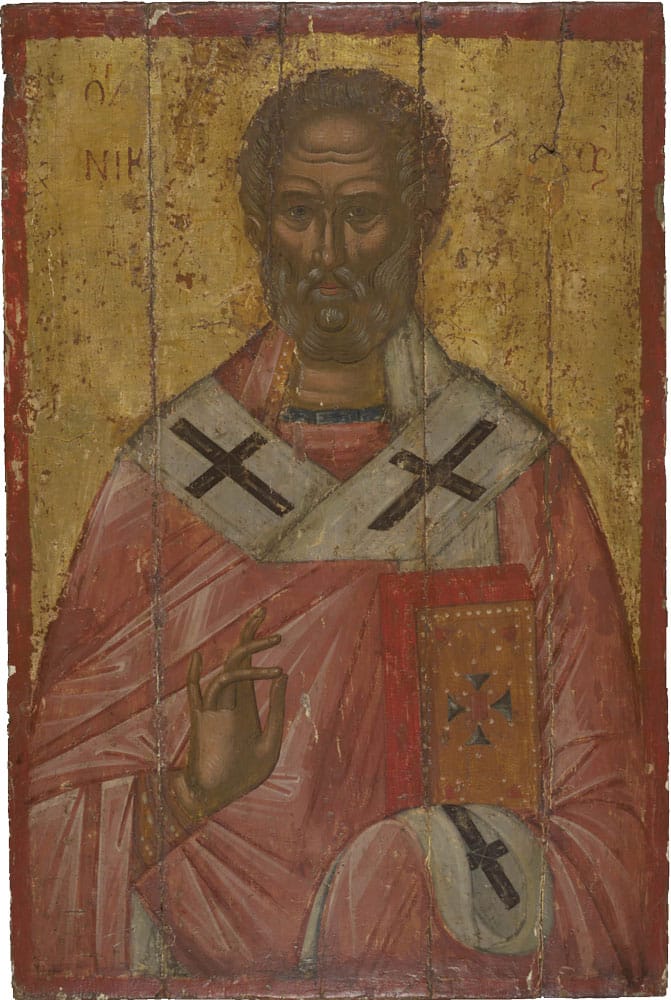
Icon with St Nicholas
Origin
Crete
Object Date
Early 16th century
Metric Dims
H. 85.3cm; W. 56.5cm
Inventory Number
Reg. no. BEP 1994,0102.1
Additional Details
(Cormack 19)
Provenance
Bequeathed by Guy Holford Dixon in 1994.

Origin
Crete
Object Date
Early 16th century
Metric Dims
H. 85.3cm; W. 56.5cm
Inventory Number
Reg. no. BEP 1994,0102.1
Additional Details
(Cormack 19)
Provenance
Bequeathed by Guy Holford Dixon in 1994.
The icon is painted in egg tempera with gold leaf on cypress wood primed with gesso over linen. On either side of the figure’s halo is a Greek inscription in red letters identifying him: Ο ΑΓ(ΙΟC) ΝIΚ(ΟΛΑ)ΟC (Saint Nicholas). Red paint was also used for the frame of the icon in the shape of a simple narrow band. He is shown in half-length, bearded, and dressed in episcopal vestments, a simple pink phelonion (chasuble) and a white omophorion (a long scarf-like garment) decorated with large black crosses, the latter signifying his status as bishop. He holds a Gospel book in his left hand, respectfully covered with his garment (one role of bishops being to teach the scriptures), and his right hand is raised in a gesture of blessing. The decoration of the gospel imitates pearls and gemstones forming a cross. The Greek inscription is abraded. The icon is formed of five pieces of wood, supported at the back with four wooden battens belonging to a recent restoration.
St Nicholas, Archbishop of Myra in Lycia, is represented on this large icon. It seems to have been part of the sanctuary screen of an Orthodox church (the iconostasis) as the patronal or ‘despotic’ icon. If so, the church may have been dedicated to St Nicholas. Two incised concentric circles divide his golden halo from the background, and similar incisions were used as preliminary drawings.
The saint’s facial features follow the conventional iconographic type established for St Nicholas in the Byzantine period and described in the 18th-century Painter’s Manual by the monk Dionysios of Fourna (Papadopoulos-Kerameus 1909; Hetherington 1974: “an old man, bald, with a rounded beard”). This icon reproduces the iconographic type of St Nicholas which appears to have been established in the second half of the 15th century by the Cretan painter Andreas Ritzos (Vassilaki 1999, 126; Chatzidakis 1985) and which became very popular in the ensuing centuries (Acheimastou-Potamianou 1986).
In terms of iconography the BM panel is identical to representations of St Nicholas signed by or attributed to Andreas Ritzos, such as the image of the saint on the border of the icon of the Ascension, Preparation of the Throne and Hospitality of Abraham, which bears the signature of the painter and is now in the National Museum of Western Art, Tokyo (Vassilaki 2010). Even though the saint is depicted full-length on the Tokyo icon, the upper part of his body is a close match to the BM’s icon. Among the icons attributed to this painter which bear very similar bust images of St Nicholas, is the tripartite panel from the Church of St Nicholas, Bari, depicting also the Virgin and St John the Theologian. Similar too is the icon of the saint from the Gonia Monastery, Crete (Borboudakis 1993). Additional elements of the Gonia icon are the small-scale images of Christ and the Virgin on either side of the saint, presenting him with the attributes of his office: a Gospel book and an omophorion. This iconographic detail, a reference to the miracle during the First Ecumenical Council at Nicaea (325), appears very frequently on icons of St Nicholas of this type (Vassilaki 1999).
As far as style is concerned, the painter of the BM icon also follows the 15th-century Cretan tradition. The modelling of the face with olive green for the shadows and warm ochre for the skin and white highlights on the forehead, cheeks and under the eyes is found in the icons of Ritzos as well as in works of Angelos Akotantos (first half of the 15th century), such as the icon of St Nicholas with scenes from his life from the C. Zymaris collection, Corfu. Yet the style of painting of the BM panel is not as sophisticated as that of the two eminent Cretan painters of the 15th century. For instance, the highlights on the forehead of the BM St Nicholas are few and bold, unlike those on images painted by Ritzos, who uses a denser network of alternating bold and fine lines. One such example is the icon of Christ Pantokrator from the Monastery of St John, Patmos. Also the rendering of the drapery folds of the BM St Nicholas is more flat and geometric by comparison to paintings of Ritzos. In view of these stylistic points, the BM icon can be ascribed to a Cretan painter of the early 16th century who is thoroughly familiar with 15th-century Cretan icons, but hardly matches their quality.
Literature: A. Papadopoulos-Kerameus (ed.), Dionysios of Fourna, Έρμηνειά τῆς ζωγραφικῆς τέχνης, St Petersburg, 1909, 154; P. Hetherington, The ‘Painter’s Manual’ of Dionysius of Fourna, London, 1974, 54; M. Chatzidakis, Icons of Patmos, Athens, 1985, 59–60, no. 9, pls 13, 15; M. Acheimastou-Potamianou (ed.), Byzantine and Post-Byzantine Art (exh. cat., Byzantine and Christian Museum), Athens, 1985–6, 108, 122–3, nos 107, 122, 123; M. Borboudakis (ed.), Εικόνες της κρητικής τέχνης. Από το Χάνδακα ως τη Μόσχα και την Αγία Πετρούπολη (exh. cat., Basilica of St Mark – Church of St Catherine), Herakleion, 1993, 518–19, no. 164; M. Vassilaki, ‘Icons of the 17th Century’, in M. Vassilaki, I. Tavlakis and E. Tsigaridas, The Holy Monastery of Aghiou Pavlou. The Icons, Mount Athos, 1999, 97–139, at 126; R. Cormack, Icons, London, 2007 (repr. 2014), no. 19, 117; M. Vassilaki (ed.), The Hand of Angelos, An Icon Painter in Venetian Crete (exh. cat., The Benaki Museum), Athens, 2010, 205–07, no. 51.
Eleni Dimitriadou